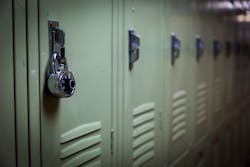U.S. K-12 schools are reopening for learning. Data from the 2021 National Assessment of Educational Progress (NAEP) School Survey found that 98% of the public schools surveyed were open for hybrid or full-time in-person instruction in May.
But getting back to in-person learning brings with it a whole host of new challenges – chief among them is how to help ensure the safety and health (both physical and mental) of students on-site. CDC research in emergency room admittance suggests the pandemic has negatively affected childrens’ mental well-being. The Department of Education has also proposed guidance for school reopenings that consider students’ anxieties about reintegrating into an in-person environment. Schools that do not consider establishing health and safety policies and processes around reopening may leave their students without the confidence they need to succeed in an in-person setting.
As schools prepare for the pandemic’s next phase, security technology can help create an environment in which students feel safe, comfortable, and confident — and one that prioritizes the health and safety of everyone on-site.
Understanding how best to integrate security technology within a school doesn’t need to be complicated. Continue reading for a step-by-step approach that administrators and school leaders can use to map out areas of opportunity to enhance the health and safety journey for students. This can provide additional insights into where policies, processes, and security technologies can help create an environment where students are protected and can thrive.
Step 1: Study the Current School Environment
Administrators should start by studying their school’s current safety journey from a student’s point of view. For example, consider questions like:
- How many steps does a student take from the front door to their classroom?
- How many doors do they come in contact with, or what high-traffic areas do they pass through?
- Do they engage with anyone else during that time?
- How do people move through your school every day?
Your answers may reveal your current path needs adjusting, or you could rediscover old vulnerabilities as you reintegrate into a school day’s usual rhythms. If your school initially deployed security technology like human temperature screening or a visitor management system, assess how it could help address new challenges as you reopen.
Also, track how students travel through areas where they used to assemble:
- Cafeterias during lunch
- Shared restrooms
- Guidance counselors’ and nurses’ offices
- Gymnasiums and playground equipment
Step 2: Reassess Health and Safety Policies and Procedures
Equipped with a fully mapped safety journey covering the school and how people interact within it, administrators can determine how health and safety policies can influence those interactions. New policies can raise difficult questions, which may sound familiar from the pandemic’s onset:
- Should you stagger class start and end times?
- Should you place students in cohorts to restrict interactions to particular groups?
- Should you redesign the building’s people flow?
- Should you have exit-only areas to reduce how many people pass through the same door?
Your answers will help you build your school’s aspirational state — the ideal environment you want to create for students as doors reopen for full-time in-person instruction. Administrators should also develop processes that enforce new or revised safety policies; hoping students simply remember to follow new policies will likely confuse them and can reduce confidence and effectiveness.
We saw that happen with schools that installed automated visitor management systems to determine a visitor’s health before entering a school. Many schools hadn’t used screening processes before COVID-19, so they fell back on cumbersome and confusing manual processes. Administrators with new technology but without proper processes couldn’t make the best use of their solutions, affecting their own confidence and those they aimed to protect.
Step 3: Use Processes to Drive Security Technology Decisions
Processes reinforce policies, but well-integrated security technologies can enhance those processes. While administrators may want to purchase solutions immediately, technology without proper planning can do more harm than good in some cases. Instead, partnering with a technology integration partner can help administrators understand the need for security and ensure it is properly implemented to protect staff and students.
Technology is a tool to help administrators create safer school environments, but they first must learn how to wield it. Administrators equipped with their school’s safety journey and aspirational plan can choose the best security technologies to bolster students’ and others’ confidence for the continuation of in-person learning.
Kyle Gordon is Vice President of U.S. Field Sales at STANLEY Security.



